|

www.tigerairways.co.uk
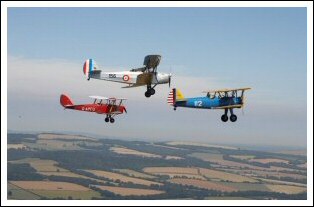
Tiger
Airways takes its name from the Tiger Moth, probably the best
known of all the 1930's Vintage Bi-planes. Tiger Airways was
the West Country's first modern provider of Tiger Moth Flights
and is still the only provider of Vintage Bi-plane Flights in
the West Midlands and South West. Offering more than simply
joy rides, pleasure flights or scenic flights, Tiger Airways
specialise in providing the public with the chance of 'hands
on' flying in World War Two Vintage, Open Cockpit, Bi-Plane,
Training Aeroplanes from the Tiger Moth era. A flight in one
of their vintage aeroplanes, designed more than seventy years
ago, is, they believe, the most enthralling of all the
experience days now on offer. Include some aerobatics in the
flight and you are enjoying the most exciting of all adventure
days.
Here
Digger talks to Chris Rollings at Tiger Airways.
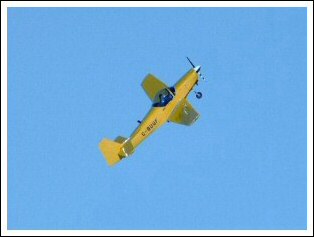
Digger:
Is it hectic at the moment?
Chris:
At this exact moment no, but give it half an hour…
Digger:
Is what you’re doing seasonal?
Chris:
Yes, to an extent.
Digger:
Did the dust cloud have an impact on you?
Chris:
We got stopped for a couple of hours at one point. One morning,
the Civil Aviation Authority and the National Air Traffic
Service got carried away and it was a mistake. It was just the
one occasion. I spent and hour and a half on the phone raising
holy hell and then they said “Oh, alright then.”
Digger:
They always err on the side of caution in this country.
Chris:
Yes, the position of responsibility these days is commensurate
with an absolute reluctance to take responsibility.
Digger:
Yes. In my day, as it were, people were left to their own
devices and to make their own health and safety choices and by
and large the phrase “It didn’t do us any harm” is true.
I’m sure there were one or two injuries...
Chris:
There probably were but are we all going to live forever now?
Digger:
That’s right.
Chris:
The culture is wrong in seeking zero risk.
Digger:
In fact, in one of life’s ironies people are artificially
seeking risks because there aren’t enough in normal life.
Chris:
Yes, some are and some always did. But the first rule should
be – if you are risking only your life or those who have
voluntarily chosen to share that risk with you, then you can
do anything.
Digger:
I agree with that.
Chris:
The second rule should be – almost no human activity is
without some risk.
Digger:
You hear lists of annual accident statistics and more people
are hurt by tea cosies than by bungee jumping.
Chris:
I’m getting into my car and driving down the road in a while
and even if I drive carefully at 30 mph I could have a
puncture or a steering failure, the car mounts the kerb and
ploughs into a couple of dozen people. Now, that risk is low
level. What actually should be done is to say – this is the
level of risk that you’re allowed to cause to other people
– one in 100,000, one in a million or whatever it happens to
be. And any activity that can be shown to be inside that level
is okay.
Digger:
I don’t know how they’d monitor that.
Chris:
You’d have to let it go on for a while and see how may
people got killed.
Digger:
I see potentially dangerous stuff on the road every day –
people driving through zebra crossings and just missing a
pedestrian, people on mobile phones driving a heavy truck
wildly around a corner and so on.
The civil servants should focus on ways to plug those
safety gaps. So, now we've sorted that all out Chris, what is
your background and can you tell us how Tiger Airways started?
Chris:
My background is that as a young lad of fourteen I joined the
Air Training Corps. Because I was interested in flying and I
scrounged flights in all sorts of RAF aeroplanes and then, at
sixteen, I did a gliding course and thought “Cor, this is
fun.” And I continued as a staff member of the local Air
Cadet Gliding School at RAF Halton. By the time I was eighteen
I was an instructor with them and a few years further on I
joined a civilian gliding club at what is now High Wycombe Air
Park. Six months later – I was a technical sales rep at the
time and then I became a professional instructor with the
intention of doing it for six months to get it out of my
system so then I could get on with a serious career.
Digger:
You obviously had an aptitude for it because you went through
at quite a pace, didn’t you?
Chris:
Well, yes I got quite good at gliding – a few national
championships and a few records.
Digger:
I used to drive to Dunstable downs and watch the gliders
launch form their catapults. It was fantastic – ground to
altitude in a few seconds.
Chris:
They’ve stopped that at Dunstable now. The only place that
still does that is Long Mynd at Stretton. I got to be quite
good at that and got a powered aeroplane licence along the
way. I spent some time as senior national coach for the
British National Gliding Association and a year or so as chief
instructor of the Mile High Gliding Corporation at Boulder,
Colorado USA. And my partner, who I met in a traffic jam on
the M6, is an airline pilot and ex-professional air display
pilot and twice the leading lady of British Contest
Aerobatics…
Digger:
It was just a coincidence that you met in a jam on the
motorway?
Chris:
Completely, but the amazing thing was that, having met in a
traffic jam on the M6, we then discovered we had enormous
numbers of friends in common and it was a remarkable chance
that we hadn’t met before.
Digger:
What prompted you to wind down the window and strike up a
conversation?
Chris:
I had a glider trailer on the back of my car and she had a
hawk on a perch at the front of her car. It was a hot Friday
afternoon. She looked across and said “Is that a glider
trailer on the back?” And I said “Yes.” And I looked at
the small hawk at the front of her car and said “Is that a
Kestrel or a Merlin?” thereby exhausting my knowledge of
birds of prey. She said “It’s a kestrel.” And at that
point I looked at the back of her car and saw a much larger
bird of prey. So I said “What have you got at the back of
the car?” And she said “A golden eagle” as if to say
“Doesn’t everybody have a golden eagle at the back of
their car?” We chatted for a bit and I gathered at this
point that she lived in Scotland and was on the way south
visiting friends and I was just on the way home from running a
soaring course at a midlands gliding club. I suggested that I
would be in Scotland in a couple of months’ time running
some soaring at Aboyne in Scotland and she might like to come
over and bring her eagle along, because the boys would love to
meet a golden eagle at close quarters. I’d take her soaring
over Scotland and we might even meet a golden eagle in the
air. We exchanged phone numbers, and subsequently when I asked
her what she did for a living she said she worked for a
transport company, failing to tell me she was a professional
pilot flying four engine jets for Air UK. When she turned up
at Aboyne, complete with the golden eagle, everybody admired
the golden eagle and then we went off in a two-seater and it
was a good soaring day so we climbed to about 17,000 feet and
then I did my aerobatics party piece to music thinking that
would impress her. When it was over she said “Can I have a
go?” – she admitted she’d done a bit of flying by this
stage so she took control of this big lumbering beast of a
glider and did two immaculate barrel rolls with it, much
better than I could do it and said “That was nice. I
haven’t done any aerobatics for a long time. I think your
choice of music was better than I used to use.” So a few
years later, we both decided we were fed up with working for
other people and wanted our own business and flying vintage
biplanes seemed the logical place to start. So Tiger Airways
was born.
Digger:
What's the biggest pleasure about what you do?
Chris:
The fact that we think that humanity wears a smile on its
face. This may sound like an exaggeration or a boast – in
nine years and probably 10 or 11,000 flights, only one person
has not said something along the lines of “That was
absolutely bloody wonderful.” With a big smile on their
face.
Digger:
Was that one exception someone who had been press ganged into
doing it?
Chris:
What he said was that “My father has bought me the flight
and he knows how terrified I am of flying and that I
wouldn’t enjoy it in the slightest but I wasn’t going to
give him the satisfaction of not doing it. And I’m glad to
have done it.”
Digger:
Well, even that was a kind of praise. It’s getting there.
(Laughs) That sort of feedback must be…
Chris:
It makes one feel good.
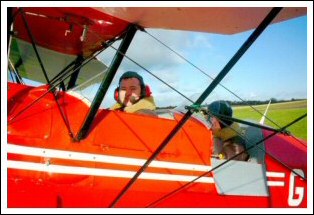
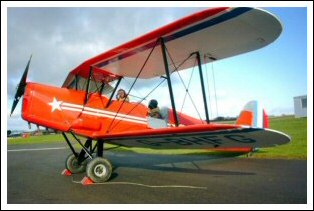
Digger:
What sorts of people fly with you? I assume every type?
Chris:
Yes, everybody. From nine year old kids who fancy the look of
it through to thirty, forty, fifty year olds who’ve always
been interested in that sort of thing to the 91 year old
ex-Battle of Britain pilot who we flew two weeks ago.
Digger:
Hmm. How many of those guys are left now?
There can’t be that many?
Chris:
Not many, but we actually had one Battle of Britain pilot two
weeks ago and we still see ex-wartime RAF pilots every couple
of months, I suppose.
Digger:
I went to a WWII day at Duxford and there were about a dozen
Battle of Britain guys signing books and paintings of their
aircraft. That was about three years ago and I’m assuming
they’re becoming fewer each year which is a shame. What
makes the Tiger Moth so special?
Chris:
Firstly I think it was the aircraft that trained the RAF
during the second world war – almost everybody who fought in
the Battle of Britain learned to fly in a Tiger Moth.
Secondly, because it was built in such large numbers it’s
the one that was around – there were around 7,000 Tiger
Moths built, and everybody knows it. I should explain that we
don’t actually have any Tiger Moths! (Both laugh) We have a
thing called a Stampe SV.4 which is a French and Belgian copy
of the Tiger Moth. It’s enough like it that it can fool RAF
pilots who learned to fly in Tiger Moths into thinking it is
one.
Digger:
I go to the Bourton motor museum and there are German and
Japanese copies of Austins from their early car production –
these were built under licence. And, of course, the
Messerschmitt fighter had a Rolls Royce engine at the start of
its life, obviously before the war.
Chris:
Everybody was copying everybody else. The other thing is that
the Tiger Moth, for many people, is a generic name for a
vintage biplane. The same way that ballpoint pens are Biros
and vacuum cleaners are Hoovers.
Digger:
Yes.
Chris:
That one’s a Boeing Stearman – that’s an American Tiger
Moth. That one’s a Bücker Jungmann – that’s a German
Tiger Moth.
Digger: When they made
the Battle of Britain movie in 1969 they still managed to get
hold of a lot of original planes because they were still in
service with the Spanish Air Force and elsewhere. Was the same
true with the Moth in that it had a long service history?
Chris: The RAF started
replacing them with the Chipmunk, a low wing monoplane with
the same engine and they first started to arrive almost
immediately after the second world war. A few Tiger Moths
carried on in use with the RAF through the fifties for things
like Air Cadet flights. I think the last navy ones didn’t
retire until the early seventies. There were only a few left
but a lot of them were dumped onto the civilian market after
the war and I understand that in 1946 you could buy one for
about £25.
Digger: And a lot of
them rotting and rusting in barns and fields?
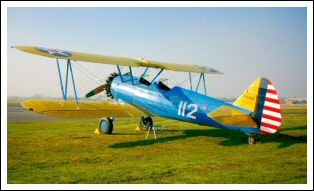
Chris: A friend of mine
joined the air force in about 1950 and did his national
service opting for three years instead of two and training as
a pilot. Quite a few people did that at that time and when he
came out he joined British European Airways as it was then and
he was an airline pilot until his retirement. He bought a
Tiger Moth in 1952 for £150.
Digger: And these
days?
Chris: I could probably
find one for sale by this afternoon if I looked hard - £50,000
give or take a little. If it’s less than £35,000 then
you’re probably going to take it home in a truck rather than
fly it home and for £70,000 you’d expect it to be the one
that is going to get the prize at the next Tiger Moth Flight.
Digger: What should
people bring apart from themselves and should they prepare in
any way?
Chris: They don’t
actually have to do anything to prepare for it. We’ll lend
them the sheepskin flying jacket and a white silk scarf and a
leather flying helmet. And we’ll show them a fifteen minute
video about how to fly the plane and how it works. If they
want to read something about it before then they can but in
practice just turn up dressed normally and we’ll do the
rest.
Digger: Do you get a
lot of repeat bookings?
Chris: Yes, quite a
few. I do keep a careful track of where all the bookings come
from and these days the largest source is The Internet and the
second largest source is word of mouth.
Digger: That’s
brilliant isn’t it?
Chris: One lady
comes back and has an aerobatic flight with us on her birthday
every year. She’s been doing that for eight years now.
Digger: How far are
they physically coming when they find you on the Net?
Chris: It’s
unusual for them to come form abroad but it does happen. We
had a chap drove down from Glasgow the day before yesterday
– they come form Liverpool, Yorkshire, Essex, Cornwall and
that’s an everyday occurrence.
Digger: Road distances
don’t mean much to people these days because the cars are
more comfortable and roads better.
Chris: 30% come
from within an hour’s drive, 30% within two hour’s drive
and the other 40% further than that.
Digger: What is it
about retro and nostalgia in all its forms? So many people
have businesses related to it. Why is it so enduringly
popular?
Chris: The short
answer is I don’t know. It’s difficult to say really. I
think there’s a feeling that it was better in the good old
days.
Digger: Maybe we just
remember the good stuff?
Chris: Okay, our planes aren’t strictly
Tiger Moths but I think with the Tiger Moth it was part of an
era when health and safety didn’t rule and people took risks
and flew them around the world. And in doing so, they helped
create the modern world. The guy who flew his Tiger Moth to
Australia was paving the way for the 747 you’ll jump on to
go on your holidays there next month.
Digger:
And with the volume of commercial flying there is these days
it’s incredible how safe it is these days.
Chris:
Quite. But the thirties was the Tiger Moth’s era and it was
the time when flying went from useless to useful. In the first
world war it became a weapon of war, but it was really during
the twenties, when air travel was a novelty, and by the end of
the thirties it was the quickest way of getting somewhere. The
guys who were flying the Tiger Moths and planes of that era
played a big part in creating the modern world. To get to look
and experience what they did it with is fascinating for anyone
who has ever thought about it. Probably on our side in excess
of 90% of the
pilots who fought in the Battle of Britain trained on Tiger
Moths.
Digger:
We wouldn’t be having this conversation if they hadn’t. So
can you take us through some of your options and packages?
Chris:
Yes, first of all, all of the flights we do are with
instructors and they all give the opportunity to do some hands
on flying. They’re not a passenger ride, they’re a come
and have a go and see what it’s like for yourself. The basic
option is a 20 minute flight and the most popular option is
probably the 30 minute one and we call it the Cotswold Flight
because you’ve got to call it something and we’re right
next to The Cotswolds. You can actually go over towards The
Malverns or down the estuary or over The Forest of Dean or
wherever somebody wants to go.
Digger:
Is there some aerobatics involved in that if you want?
Chris:
If you want, yes. Basically at some point in the flight the
instructor will say “While we’re up here do you want to
see the world upside down and do a barrel roll?
Digger:
(Laughs) I’ll hit my clipboard against the dashboard…
Chris:
Probably 75 to 85% say yes, it’s not universal. For those
who specifically know before they start that throwing the
world around a bit is what they want, we do two specific
aerobatic options. There’s a 25 minute introduction to
aerobatics which is a slightly abbreviated version of the
Cotswold Flight really with a chance to do a loop and a roll.
For the really adventurous, we do a 35 minute full-blooded
aerobatic flight with two choices – you can either have the
instructor to teach you how to fly the aeroplane around a
barrel roll which is the easiest of all aerobatic manouvres.
Yes, that really does mean someone who’s never flown before.
Digger:
So you don’t need any flying qualifications or experience at
all?
Chris:
None whatsoever. Or the alternative which is what most people
will go for - the instructor will show you how he or she flies
a full contest display or sequence – the sort of thing
you’d see if you want along to an airshow, from the
driver’s point of view with a running commentary being done.
Digger:
I was surprised when I was at Sywell aerodrome at how small an
amount of airspace these biplanes need to perform their
aerobatics.
Chris:
Basically, biplanes tend to fly slowly compared to most modern
aeroplanes and the turn radius, all things being equal, varies
with the square of the speed you’re doing it. So with our
Tiger Moths or biplanes the maximum speed used for aerobatics
is around 100 knots, maybe a touch over, so 120 mph. The Red
Arrows will be going up to 250 knots, nearly 300 mph. Two and
a half times faster using 5 or 6 times as much sky.
Digger:
Pardon the pun but in what direction are you taking the
business?
Chris:
What I’d like to do is slightly expand the variety – an
acquaintance in Germany is actually trying to put back into
production, to the original drawings, the German Bücker Jungmann,
which is their equivalent of the Tiger Moth. Very similar, the
same shape but slightly smaller - if you park it next to a
Tiger Moth it’s a little bit smaller and actually a little
bit more agile.
Digger:
You could simulate dogfights?
Chris:
Yes, I want to do that. It’s a bit artificial because the
Tiger Moths were never used in combat. And the German Bücker Jungmann
was used right at the end of the war when they put bomb racks
on them and used them when things were really desperate and
they were losing light hell. But, there’s no reason not to
simulate combat in them and it would have been part of the
training. The other thing is that would be quite interesting
to someone who is interested in that part of the war so they
could come along and try both sides of basic training and see
what the British learned to fly in and what the Germans
learned to fly in for the Battle of Britain. Come and try them
both on the same day and see what you think.
Digger:
Do you do a video of the experience?
Chris:
Usually yes.
Digger:
That’s good because these days people would like and maybe
expect a visual record of their flight to take away with them
as well, wouldn’t they?
Chris:
We try to make it a day to remember and the video is a great
memento of a great day.
Digger:
Well Chris, thank you for that, I’ve learned a lot about
vintage biplanes and what you are doing with them. It has been
fascinating and I wish
you every success in the future.
Chris:
Many thanks David.
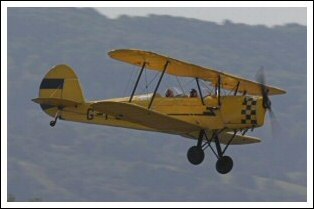

www.tigerairways.co.uk
Tiger
Moth Flights, Modern Flights, Aerobatic Flights, Spitfire
Flights, Stearman Biplane Flights, Wing Walking, Learn To
Fly
Chris Rollings
Operations Manager
Churchdown
Gloucestershire
GL3 2AP
United Kingdom
01452 854141
|